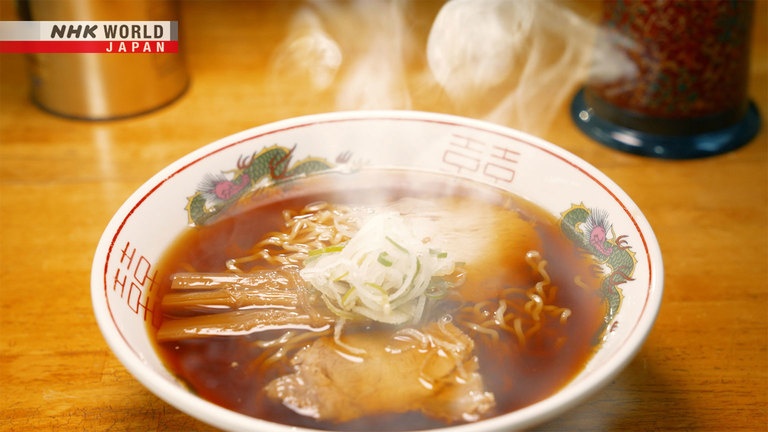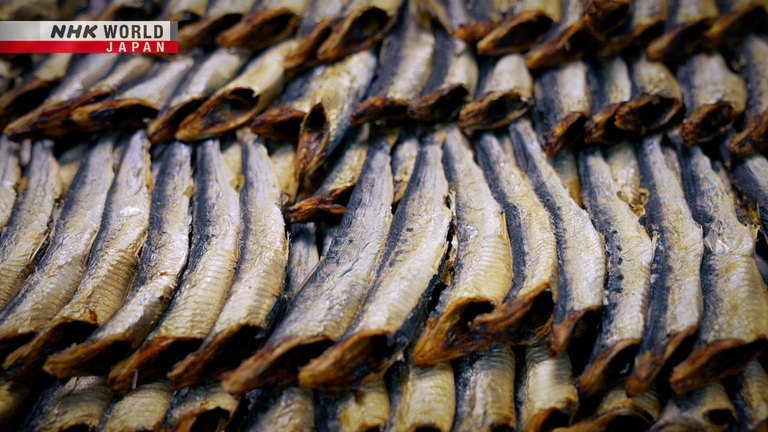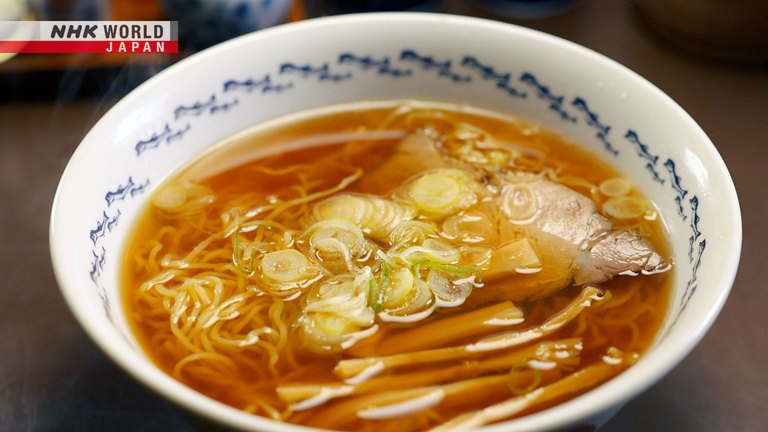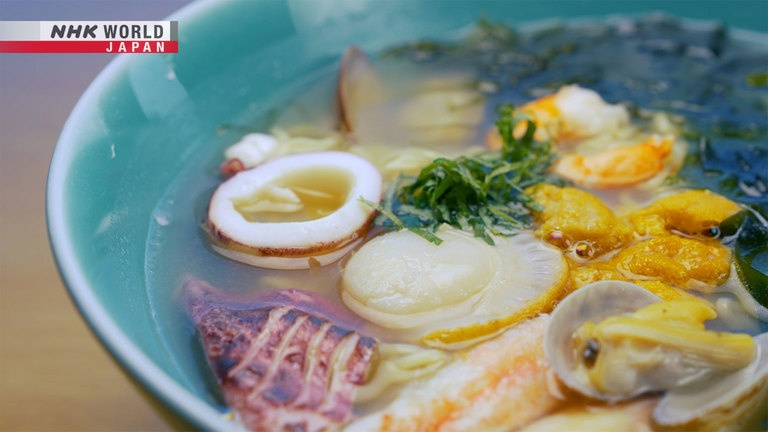AOMORI
Ramen packed with seafood goodness, loved in bitter cold northern Japan for over 100 years. Try a bowl for yourself!




Transcript
RAMEN JAPAN!
This time in Aomori, on the northernmost tip of Japan's main island.
A hearty bowl of ramen loved in bitter cold northern Japan for over 100 years.
Welcome to Japan, the land of ramen!
Looking out on the Pacific, the seaside town of Hachinohe.
Home to industry and maritime commerce, this is also one of Japan's busiest fishing ports.
So naturally, the distinctive local ramen can be found on the seaside.
This is seafood ramen!
To a salty soup base, they add shrimp, scallops, crab, even sea urchin...
Every bowl overflowing with the bounty of the sea.
The ocean view makes
the smell of the sea even stronger.
Hachinohe catches more squid than anywhere else in Japan, and is now a city of abundance.
But it hasn't always been so.
Suffering multiple famines, local residents struggled to survive.
February: the Enburi festival is held to pray for a bountiful harvest in the coming year.
Passed down for over 800 years, it serves as an earnest plea for sufficient food.
Another local favorite has long been made here.
So beloved, that they call it, "Hachinohe Ramen."
Come in!
What makes it so special is the soup.
Sardines simmered and dried, or "niboshi," used for the classic dashi stock base.
The fish we use are caught nearby.
The taste of locally sourced ingredients.
This is the standard, created around
100 years ago when ramen first came here.
This customer was born and raised here.
This is what I call ramen!
In my teens I went to school in Hokkaido,
then University in Kyoto and work in Tokyo.
This was what I missed most.
Nothing special, just that sardine dashi.
To me, it's an everyday taste of home.
This Hachinohe noodle maker has been here for over 75 years.
Hachinohe ramen noodles are yellowish,
with a slight wave, about 1 to 1.2mm.
That wave allows you to enjoy the
sardine broth flavor as you slurp.
Ramen first appeared in Hachinohe in 1928.
It was made by Tei Kokusen, originally from China.
He had been operating ramen shops in the Tokyo area,
but his business was devastated by the Great Kanto Earthquake.
He then moved to Hachinohe opening his restaurant, Rairaiken, where he began offering ramen.
That original shop no longer remains.
The owner of this shop, Sugimoto Takashi, age 74, is one of the few people who still remember.
He comes from a family of noodle makers.
I often spent time there as a kid.
Going in, the first thing to hit you
was the aroma of sardines.
The characteristic Hachinohe sardine-based soup also got its start at Tei's restaurant.
I've eaten ramen all over Japan.
Ask what they use to make dashi for
miso soup, say bonito and kombu,
and that's what's used in their ramen.
The point is it's never anything pricy.
You make do with what's available.
This woman has lived in Hachinohe for close to 50 years.
She's preparing her usual dinner.
Local food, simmered dishes and such,
always has dashi made from sardines.
It's the way it's been since the old days,
and it's the best thing for miso soup.
The aroma of dried sardine dashi wafting through the homes of local residents stimulates the appetite.
The sardine broth is delicious!
A double portion for me today!
In cold weather it helps cheer me up.
Ramen is my clearest childhood memory.
For celebrations, or after festivals
we'd eat as a family. It was exciting.
Eating it always takes me back.
Every bowl is full of memories.
Dried sardine "niboshi" dashi, a staple here for centuries.
And Hachinohe ramen is infused with that simple taste of home.
Aomori is split between the Nanbu and Tsugaru regions,
each with its own language and food culture.
And next on the menu, is Tsugaru ramen.
The Tsugaru shamisen is
the heart of the Tsugaru people.
When we hear it we get excited.
Tsugaru shamisen player, Shibutani Kazuo.
He also runs this dining bar.
Tsugaru cuisine includes dishes like...
"Kenoshiru:" mixed vegetable stew.
"Kaiyaki-miso:" scallops grilled with miso and egg.
Alongside these local classics...
Ramen!
The soup is on the salty side.
You can't help drinking every drop.
The city of Aomori faces Mutsu Bay.
With average annual snowfall over 5m,
it's one of the snowiest cities in the world, but there's been little snow this year.
After a long while, today it's finally snowing, and the temperature is -1℃.
Welcome!
This long-running ramen shop opened in 1948.
Tsugaru ramen is all about the soup.
For Tsugaru ramen we use "yakiboshi,"
grilled dried sardines, to make the soup.
"Yakiboshi" is a similar but different type of dried sardines.
It's mainly produced along the shores of Mutsu Bay.
Let's see how they're made.
First, one by one, tiny sardines are gutted and cleaned to remove any bitterness.
They're then left to dry in the sun and skewered,
and instead of simmering like "niboshi," they're grilled over charcoal.
This process removes excess fat and water and adds a savory smoky aroma.
They have a much lighter flavor
than niboshi, with a pleasant aftertaste.
Long-time customers love the flavor.
They just can't pass it up.
The shop opens at 7:30 in the morning.
As soon as they do, the regulars start coming in.
I love it. I've been coming for years.
My parents brought me in as a kid.
This place is the best!
I take the bus to come eat here.
I save my appetite and come early.
The soup has a natural taste.
I can just keep on eating.
I'll be 87 this July!
Tsugaru ramen's use of "yakiboshi" has its roots in local food culture.
Since the old days we've used it
to make dashi for miso soup.
Our shop used to sell soba and we used
"yakiboshi" for our soup stock.
The Tsugaru castle town of Hirosaki.
Classic Tsugaru ramen has been made in this shop for generations.
Come in!
Founded near the turn of the 20th century, they've been in business for close to 120 years.
Kuronuma Michio is the fourth-generation owner.
We also started out making Tsugaru soba.
The local style of soba has been around for hundreds of years.
It features softer noodles, a blend of buckwheat and soy flour, that take three days to make.
All we add to the "yakiboshi" stock
is soy sauce and kombu.
It has the savory aroma of the sardines.
Ramen came sometime in the 1920s.
Although few details are known,
Tsugaru ramen is indeed believed to date back to the 1920s, and likely spread via soba shops.
We boil the noodles over a wood stove.
We just keep on maintaining it.
I've been eating here for 50 years.
The soup is fantastic.
It's nice and light, easy to eat.
I just love it.
I just do what my father taught me.
120 years. Customers keep coming,
so we could never change the taste.
The savory home-cooked aroma of dried sardine dashi beckons.
This is Aomori ramen.
A taste unchanged for over a century,
a deep nostalgia in every bite.
Today, on the menu once again.
Here's hoping that taste never fades.